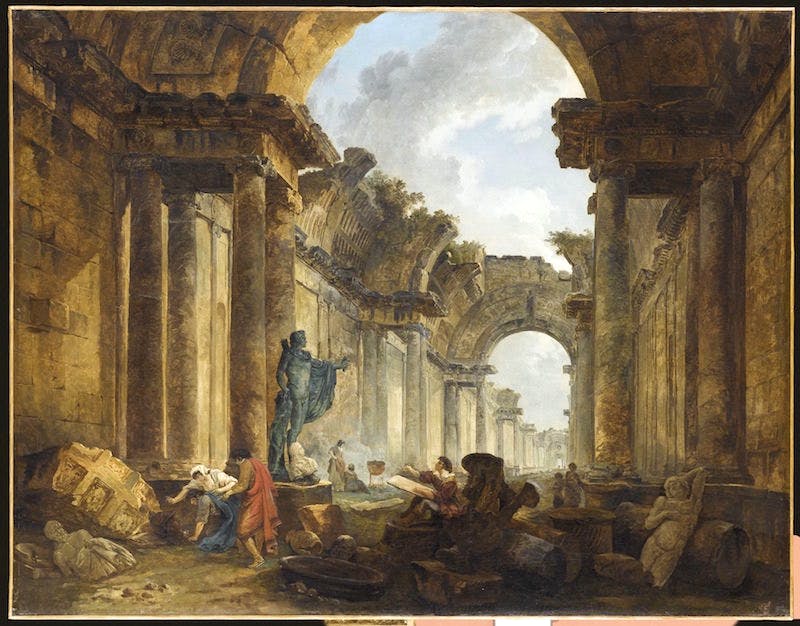Jillian Holbrook
AP European History 🇪🇺
335 resourcesSee Units
Ah, romance.
.webp?alt=media&token=17310daa-c0eb-4fff-b9f0-70b1f543dc0f)
Romanticism marked an artistic, literary, and intellectual movement that originated in Europe in the late 18th century and spread to the Americas in the 19th century. It emphasized emotion, imagination, and individuality as a reaction against the rationalism and order of the Enlightenment and Scientific Revolution.
The Romantic movement developed under philosopher Jean-Jacques Rousseau, who questioned the need for complete reliance on logic—emphasizing that emotion led to moral and societal improvements. At its core, romanticism developed alongside the Enlightenment but in opposition to its strict rationality and the suppression of emotion in favor of reason. Romanticism was characterized by a focus on the natural world, a reverence for the past and for folklore and myth, including an interest in the supernatural and the occult.
As a reaction to the perceived excesses of the Enlightenment, which emphasized rationality, individualism, and progress at the expense of tradition, community, and nature, the Romantic movement celebrated a return to the emotional, intuitive, and spiritual aspects of human experience. Contextually, revolution, war, and rebellion demonstrated emotional power for mass politics and nationalism, which contributed to the revival of public expression.
Romantic artists and writers sought to capture the emotional and expressive qualities of their subjects and often drew inspiration from nature and the lives of ordinary people.
Romantic Art
Romanticism in art focused on emotion and the expression of the artist's inner feelings, including a preference for the picturesque and the dramatic. Romantic artists often used bright colors and bold brushstrokes to convey the intensity of their emotions, and their works often featured dramatic landscapes and heroic figures.

Imaginary View of the Grand Gallery of the Louvre in Ruins, Hubert Robert (1796) (Louvre)
.jpg?alt=media&token=07ef799c-04a3-4ec7-983a-004cac483a38)
The Shadows of French Heroes who died in the wars of Liberty, received by Ossian Anne-Louis Girodet, (1802) (Château de Malmaison)
.jpg?alt=media&token=18677f10-575a-4227-a106-bb75c21368d6)
Liberty Leading the People, Eugène Delacroix (1830)
While Romantic art was all about emotional expression with dramatic uses of color and movement, it was also heavily inspired by “exotic” settings, such as the Middle East and Egypt, and the passions of war. One of the most famous romantic paintings is French artist Eugène Delacroix’s Liberty Leading the People. This work of art combines revolutionary passion with the bold red, white, and blue colors of the French flag.
Romantic Literature
In literature, romanticism is associated with an emphasis on imagination and emotion. It also incorporates a fascination with the exotic and the mysterious. Romantic writers often used symbolism and allegory to convey their ideas, and their works often featured unconventional heroes and heroines who defied societal norms.
Characteristics of Romantic Literature
Romantic literature was characterized by a few key indicators:
- Focus on the narrator/writer’s emotions and inner thoughts
- Rejection of rationalism and industrialization
- Emphasis on nature, beauty, personal expression, and imagination
- Idealization of the family (women and children) and rural life
- Use of common language and subjects
Johann Wolfgang von Goethe
An example of romantic literature is Johann Wolfgang von Goethe’s story, The Sorrows of Young Werther. Since the novel is written in the form of letters, a popular literary device used by the Romantics, its style allows for a deeper insight into the thoughts and emotions of the protagonist, Werther, and provides a more intimate and personal perspective on his experiences. The setting of the novel is the German countryside, a sharp contrast to the urbanization and industrialization of the time. Its thematic elements focus on unrequited love and the struggles of an individual against societal norms.
Most importantly, Werther is a quintessential Romantic hero who is passionate, sensitive, and deeply emotional. He is a complex and multi-dimensional character driven by his intense feelings and is ultimately unable to find happiness within the constraints of society. When he cannot be with his love Charlotte, he takes his own life.
Jane Austen
Jane Austen's works are considered part of the Romantic movement in literature because they focus on the inner lives and emotions of her characters, which depict personal relationships and individual experiences in a realistic and relatable way. The stories often center around love and marriage, exploring themes such as social class and self-discovery. Additionally, her writing style is known for its wit, irony, and attention to detail, which are hallmarks of Romantic literature.
Overall, Romanticism was a movement that celebrated emotion, imagination, and individuality and sought to break free from the constraints of rationalism and the Enlightenment.
Romanticism placed more emphasis on emotion; it marked a rejection of cold rationalism and logic. The passion for revolution and war spurred a return to base instincts and feelings. Romantic artists emphasized emotion, nature, and national histories. Romantic writers expressed similar themes and responded to current events.
🎥 Watch: AP Europe - French Revolution & Neoclassical Art
Browse Study Guides By Unit
🎨Unit 1 – Renaissance & Exploration
⛪️Unit 2 – Reformation
👑Unit 3 – Absolutism & Constitutionalism
🤔Unit 4 – Scientific, Philosophical, & Political Developments
🥖Unit 5 – Conflict, Crisis, & Reaction in the Late 18th Century
🚂Unit 6 – Industrialization & Its Effects
✊Unit 7 – 19th Century Perspectives & Political Developments
💣Unit 8 – 20th Century Global Conflicts
🥶Unit 9 – Cold War & Contemporary Europe
📚Study Tools
🤔Exam Skills
👉Subject Guides

Fiveable
Resources
© 2025 Fiveable Inc. All rights reserved.